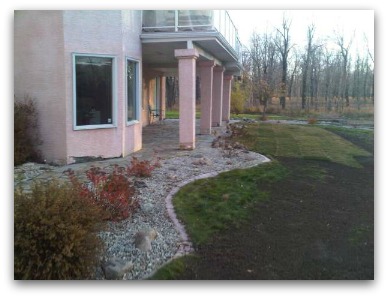F. Rebuilding a Lawn
Rebuilding a lawn is your second choice when it comes to lawn renovation. Unlike replacement, it involves working with, or modifying the soil and lawn you already have.
Tilling and amending existing soil is the most effective, and preferred choice of the three rebuilding options we will cover.
Sodding and seeding over existing lawns can be a little more challenging. These methods involve hard work, but can save you lots of money.
If you live in rocky regions, where soil is at a premium, then tilling and building your own soil base may be the best way to go if you are on a budget. It's also a great option for those of you with difficult yards to access with equipment.
All methods have been done successfully by thousands of homeowners, but they do involve some risk. You may not always share the same success that others have had. No two yards are alike. So it's important to prepare as best you can.
Remember when you were in school studying for a test? The more you prepared, the greater success you achieved. This is also true with your lawn when it comes to prep work.
We also have information for those of you looking to lay sod directly over existing grass. There is much controversy around this method, yet it can work. Like we said, the key is the prep work. Even this method will have a certain amount of prep work to it.
Almost anything can be done successfully, if the time and effort goes into preparing things before you begin. A lawn is like anything else in your life. You will get out of it what you put into it.
Removing Sod
One option you can consider is removing lawn with the use of a sod remover. It does not always have to be done, but it will make most of the tasks much easier. It will help greatly in having a smoother lawn. This will be discussed again with the three options we give.
Just remember that you are now creating a new job by having to get rid of the rolls of sod you peel up.
If you are not familiar with removing sod, here is a video to help explain.
Three common methods of Rebuilding a Lawn
Let's briefly go over the the three most common methods of rebuilding a lawn, then separate each into it's own section. Then we will give you more specifics for each option, as well as the pros and cons. Each section will also have tips to increase your percentage of success.
1. Tilling and Amending.
You can rebuild a lawn by amending and tilling your existing soil with topsoil, compost or other organics. This is a great way to ensure you have a good soil base, but requires the most amount of work. You will have choices in this section like,
- Should you remove the old grass first?
- Should you chemically treat or remove weeds?
- What amendments will you use?
- Should you seed or sod after tilling?
2. Adding soil over existing grass.

This lawn was rebuilt and graded by adding soil, seed and sod over an existing lawn.
A combination of methods were used to blend the repairs with the existing Lawn.
To see the results the following season, go to our Adding soil over existing grass section.
This option can work as well, but prep work is the key. In this section we will look at how much soil you should add, and the changes the new levels can make in your yard.
If your problem was poor soil, you are going to be building a whole new base of soil for your lawn. This means 4 to 6 inches minimum. If your yard will not accept this new change in soil height for proper drainage or blending with existing features, then there is option #3.
3. You can seed or sod directly on top of what was already there.
This is done by many landscape companies with success. It is the fastest and cheapest way to rebuild your lawn, but has to be done with caution. This is not recommended for people with existing poor soil conditions.
The grass may look fine the first year, but as the roots of the new lawn drop into the poor soil layer, you may end up with the same issues you had before you started. You will also have to do some prep work with this method.
We don't recommend this method for a long term healthy lawn. However, you can increase your rate of success if you are willing to employ ongoing improvments.
This means watering correctly, aerating, and improving your soil with organic topdressing on a yearly basis. By doing these things, you will slowly be improving the soil over time.
Let's get into some more specifics of each rebuilding option starting with Amending Soil.
______________________________________
Table of Contents: Lawn Problems
C. Lawn Repair
E. Replace Lawn
H. How to Sod
______________________________________
Return to the Lawn Problems Introduction
Go to the Dream Yard Home Page from Rebuilding a Lawn
Check out our time and money saving e-book
How to avoid the biggest mistakes made by DIYers, designers, and landscaping companies.
Visitor
Favorites
Giggles 'n' Thoughts





